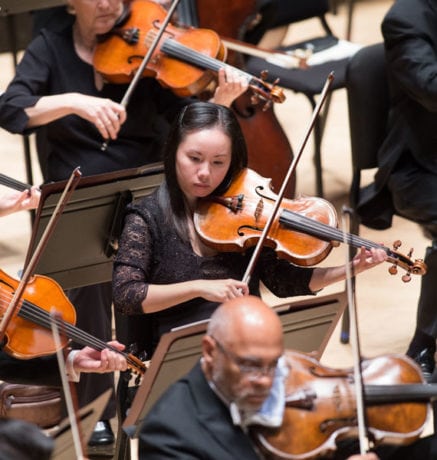The Philadelphia Orchestra set of concerts during the last weekend of February was one of the most imaginatively conceived in recent memory.
The program consisted of selections from Brahms’ Eleven Chorale Preludes, Bach’s Cantata No. 150, and Brahms’ Symphony No. 4.

Johannes Brahms is the favorite composer of Yannick Nézet-Séguin. Most musicians will avoid picking a favorite, just as a parent finds it impossible to name a favorite child, but Yannick has gone on record with his choice. In this program he showed us his idol at the end of his composing career.
The tightly-connected program included music by Bach that inspired Brahms, and the last piece Brahms ever finished, with him saying “O world, I must leave you”; then his last symphonic composition.
Many of us, like Yannick, fell in love with Brahms’s romantic melodies. As we become more knowledgeable we observe that his work is strongly grounded in Baroque counterpoint, especially the work of Bach. This combination of heart and mind, of emotion and intellect, is the essence of Brahms.
At the age of 63, in 1896, Brahms was diagnosed with terminal liver cancer. His mind was on the end of life as he wrote a series of Chorale Preludes. Despite the misleading word “chorale,” they were pieces for organ. Yet they were based on Lutheran hymns, and the last notes which he composed were for a hymn with the words mentioned above, “O Welt, ich muss dich lassen” — “O world, I must leave you; I travel from here along my way to the everlasting fatherland.”
In this valedictory, each musical phrase is repeated twice, getting softer each time. Harmonies keep shifting within those repeats, retreating into minor-key echoes.
Yannick presented some of the Preludes in new orchestral transcriptions by Detlev Glanert, and some as organ solos played by Peter Richard Conte. This alternation was brilliant in concept but uneven in execution because the organ, even at its softest, tended to overwhelm the sounds from the orchestra.
After the chorales, the orchestral players left the stage and their chairs and music stands were removed because the next number on the program required much smaller forces. After a few minutes of clatter, Nezet-Seguin came back to talk to the audience about the music. After that, a small coterie of players arrived for the next piece, seven selections from Bach’s Cantata No. 150.
It would have been wise to play the Bach first, with its tiny ensemble, and then have the additional players join the others. This would be smoother logistically, and it would make sense to show Brahms’s source, the Bach, before playing his resulting composition.
Forgetting about this quibble, the Bach was beautifully sung by four resident artists from the Academy of Vocal Arts: soprano Vanessa Vasquez, mezzo Chrystal E. Williams, tenor Jonas Hacker, and bass-baritone André Courville. Bach wrote this for singers with solo instrumentalists, but Yannick added extra strings to create a better balance on the wide stage of the 2500-seat theater. The result was a lovely blend.
The melodies were lilting and catchy. Twenty fiddles supported the voices gently while bassoonist Daniel Matsukawa added punchy counterpoint.
The second half of the concert was devoted to Brahms’s last symphony. Brahms was unlike his predecessor symphonists. Haydn wrote 102 symphonies, Mozart 41 in his short life, and Beethoven 9. But even though Brahms lived a relatively long life, he chose to publish only four symphonies. His First was a tribute to Beethoven in its fierce, pounding drama; his Second was reflective, alternating between happy and melancholy. The Third was the sunniest and most contented, and the Fourth was his most monumental.
It has a connection to the other works on the program because of its classical structure. Like the Bach and like the Chorale Preludes, this symphony has a prominent passacaglia (similar to a chaconne with the slight difference that the subject can appear in multiple voices). A distinctive bass line is repeated in different registers; that is, the same notes are repeated, higher or lower, while different melodies unspool above it. This encapsulates the essence of Brahms — romantic expressivity grounded on a traditional structural base (and bass). The “ground bass” here used the same progression as the final chorus of Bach’s Cantata No. 150.

Nézet-Séguin led the symphony at relatively fast tempi, and he eliminated the normal pauses between the first and second movements and, again, between the third and fourth. This emphasized the structure and made additional sense because the second and the fourth begin with chords that align with the endings of the first and third. He allowed a brief breathing space between the second and the third.
All of the inner strands were cleanly delineated, while the traditionally warm and rich sound of the Philadelphia Orchestra capped it all. Jeffrey Khaner played a gorgeous flute solo during the fourth movement.
The Philadelphia Orchestra; Yannick Nézet-Séguin – Conductor; Peter Richard Conte – Organ; Vanessa Vasquez – Soprano; Chrystal E. Williams – Mezzo-soprano; Jonas Hacker – Tenor; André Courville – Bass-baritone. Brahms – Selections from Eleven Chorale Preludes, Op. 122; Bach – Cantata No. 150, “Nach dir, Herr, verlanget mich,” BWV 150; Brahms – Symphony No. 4 in E minor, Op. 98 was performed on February 23, 24, and 25, 2017, at Verizon Hall at the Kimmel Center for the Performing Arts – 300 South Broad Street, in Philadelphia, PA. For tickets to future concerts and shows, call the box office at (215) 893-1999, or purchase them online.




